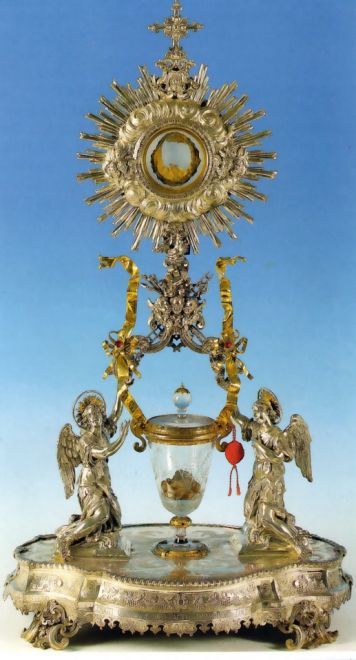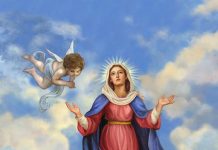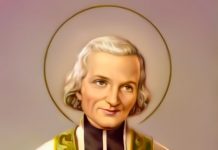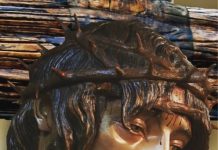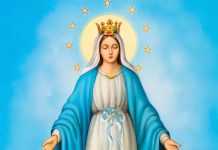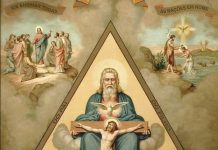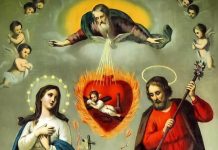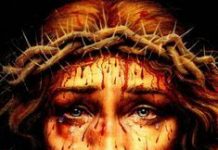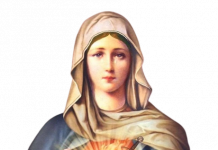Siena, Italy — 1730
The second Eucharistic miracle of Siena has roots in the 13th century when special services and festivities were introduced in honor of the feast of the Assumption of the Blessed Virgin Mary. These observances became traditional and were still conducted at the time of the miracle. So it was that on August 14, 1730, during devotions for the vigil of the feast, while most of the Sienese population and the clergy of the city were attending these services, thieves entered the deserted Church of St. Francis. Taking advantage of the friars’ absence, they made for the chapel where the Blessed Sacrament was kept, picked the lock to the tabernacle and carried away the golden ciborium containing consecrated Hosts.
The theft went undiscovered until the next morning, when the priest opened the tabernacle at the Communion of the Mass. Then later, when a parishioner found the lid of the ciborium lying in the street, the suspicion of sacrilege was confirmed. The anguish of the parishioners forced the cancellation of the traditional festivities for the feast of Our Lady’s Assumption. The Archbishop ordered public prayers of reparation, while the civil authorities began a search for the consecrated Hosts and for the scoundrel who had taken them.
Two days later, on August 17, while praying in the Church of St. Mary of Provenzano, a priest’s attention was directed to something white protruding from the offering box attached to his prie dieu. Realizing that it was a Host, he informed the other priests of the church, who in turn notified the Archbishop and the friars of the Church of St. Francis.
When the offering box was opened, in the presence of local priests and the representative of the Archbishop, a large number of Hosts were found, some of them suspended by cobwebs. The Hosts were compared with some unconsecrated ones used in the Church of St. Francis, and proved to be exactly the same size and to have the same mark of the irons upon which they were baked. The number of Hosts corresponded exactly to the number the Franciscan friars had estimated were in the ciborium — 348 whole Hosts and six halves.
Since the offering box was opened but once a year, the Hosts were covered with the dust and debris that had collected there. After being carefully cleaned by the priests, they were enclosed in a ciborium and placed inside the tabernacle of the main altar of the Church of St. Mary. The following day, in the company of a great gathering of townspeople, Archbishop Alessandro Zondadari carried the Sacred Hosts in solemn procession back to the Church of St. Francis.
During the two centuries that followed it has sometimes been wondered why the Hosts were not consumed by a priest during Mass, which would have been the ordinary procedure in such a case. While there is no definite answer, there are two theories. One explanation is that crowds of people from both Siena and neighboring cities gathered in the church to offer prayers of reparation before the sacred particles, forcing the priests to conserve them for a time. The other reason the priests did not consume them might well have been because of their soiled condition. While the Hosts were superficially cleaned after their discovery, they still retained a great deal of dirt. In such cases it is not necessary to consume consecrated Hosts, but it is permitted to allow them to deteriorate naturally, at which time Christ would no longer be present.
To the amazement of the clergy, the Hosts did not deteriorate, but remained fresh and even retained a pleasant scent. With the passage of time the Conventual Franciscans became convinced that they were witnessing a continuing miracle of preservation.
Fifty years after the recovery of the stolen Hosts, an official investigation was conducted into the authenticity of the miracle. The Minister General of the Franciscan Order, Father Carlo Vipera, examined the Hosts on April 14, 1780, and upon tasting one of them he found it fresh and incorrupt. Since a number of the Hosts had been distributed during the preceding years, the Minister General ordered that the remaining 230 particles be placed in a new ciborium and forbade further distribution.
A more detailed investigation took place in 1789 by Archbishop Tiberio Borghese of Siena with a number of theologians and other dignitaries. After examining the Hosts under a microscope, the commission declared that they were perfectly intact and showed no sign of deterioration. The three Franciscans who had been present at the previous investigation, that of 1780, were questioned under oath by the Archbishop. It was then reaffirmed that the Hosts under examination were the same ones stolen in 1730.
As a test to further confirm the authenticity of the miracle, the Archbishop, during this 1789 examination, ordered several unconsecrated hosts to be placed in a sealed box and kept under lock in the chancery office. Ten years later these were examined and found to be not only disfigured, but also withered. In 1850, 61 years after they were placed in a sealed box, these unconsecrated hosts were found reduced to particles of a dark yellow color, while the consecrated Hosts retained their original freshness.
Other examinations were made at intervals over the years, the most significant being that of 1914, undertaken on the authority of Pope St. Pius X. For this inquiry the Archbishop selected a distinguished panel of investigators, which included scientists and professors from Siena and Pisa, as well as theologians and Church officials.
Acid and starch tests performed on one of the fragments indicated a normal starch content. The conclusions reached from microscopic tests indicated that the Hosts had been made of roughly sifted wheat flour, which was found to be well preserved.
The commission agreed that unleavened bread, if prepared under sterile conditions and kept in an airtight, antiseptically cleaned container, could be kept for an extremely long time. Unleavened bread prepared in a normal fashion and exposed to air and the activity of micro-organisms would remain intact for no more than a few years. It was concluded that the stolen Hosts had been both prepared without scientific precautions and kept under ordinary conditions which should have caused their decay more than a century before. The commission concluded that the preservation was extraordinary, “…e la scienza stessa che proclama qui lo straordinario.”
Professor Siro Grimaldi, professor of chemistry at the University of Siena and director of the Municipal Chemical Laboratory, as well as the holder of several other distinguished positions in the field of chemistry, was the chief chemical examiner of the holy particles in 1914. Afterward, he gave elaborate statements concerning the miraculous nature of the Hosts, and wrote a book about the miracle entitled Uno Scienziato Adora (A Scientific Adorer). In 1914 he declared:
The holy Particles of unleavened bread represent an example of perfect preservation … a singular phenomenon that inverts the natural law of the conservation of organic material. It is a fact unique in the annals of science.
In 1922 another investigation was conducted — this one in the presence of Cardinal Giovanni Tacci, who was accompanied by the Archbishop of Siena and the Bishops of Montepulciano, Foligno and Grosseto. Again the results were the same: the Hosts tasted like unleavened bread, were starchy in composition and were completely preserved.
In 1950 the miraculous Hosts were taken from the old ciborium and placed in a more elaborate and costly one, which caught the eye of another thief. Thus, despite the precautions of the clergy, another sacrilegious theft occurred on the night of August 5, 1951. This time the thief was considerate enough to take only the container and left the Hosts in a corner of the tabernacle. After counting 133 Hosts, the Archbishop himself sealed them in a silver ciborium. Later, after being photographed, they were placed in an elaborate container which replaced the one that had been stolen.
The miraculously preserved Hosts are displayed publicly on various occasions, but especially on the 17th of each month, which commemorates the day they were found after the first theft in 1730. On the feast of Corpus Christi the Sacred Hosts are placed in their processional monstrance and triumphantly carried in procession from the church through the streets of the town, an observance in which the whole populace participates.
Among many distinguished visitors who have adored the Hosts was St. John Bosco. They were likewise venerated by Pope John XXIII, who signed the album of visitors on May 29, 1954, when he was still the Patriarch of Venice. And although unable to visit the miraculous Hosts, Popes Pius X, Benedict XV, Pius Xl and Pius Xll issued statements of profound interest and admiration.
With a unanimous voice, the faithful, priests, bishops, cardinals and popes have marveled at and worshiped the holy Hosts, recognizing in them a permanent miracle, both complete and perfect, that has endured for over 250 years.
By this miracle the Hosts have remained whole and shiny, and have maintained the characteristic scent of unleavened bread. Since they are in such a perfect state of conservation, maintaining the appearances of bread, the Catholic Church assures us that although they were consecrated in the year 1730, these Eucharistic Hosts are still really and truly the Body of Christ. The miraculous Hosts have been cherished and venerated in the Basilica of St. Francis in Siena for over 250 years.
Eucharistic Miracle
Amsterdam, Holland — 1345
In 1345, a man who was a devout Catholic became very ill. He told his family he would like to receive Holy Viaticum. The family notified the pastor of the then known Old Church. The priest, after administering the sacrament, advised the family, if the ill man threw up (which he was known to do after taking nourishment) they were to empty the contents in the fire. The man threw up and the family did what they were advised to do by the priest, they threw the contents in the fire in the sick room. This incident occurred on March 12th.
Early the next morning, one of the women went to rake the fire and she noticed in the middle of the grate, the Blessed Sacrament in the form of host. A light surrounded it. The woman became upset and immediately put her hand in the fire to rescue the host. This she did without any ill effects to herself. She did not burn her hand. The woman was surprised to find the host was cold! She immediately called in a neighbor and asked her to take the Sacred Host to her home. The neighbor took a clean cloth, placed the host on it and locked it in a box. She then took it home. When the husband of the woman who found the host heard what had taken place, he requested to see it. He tried to lift it off the white cloth it rested on but the Sacred Particle resisted as if to say it did not want to be touched by this man’s hands.
A priest was then summoned who took the host and placed it in a pyx. When he went to wash the cloth which held the Blessed Sacrament and return it to the original box, he noticed the pyx was upset and the host was gone!
The next morning the neighbor returned for her original box and cloth. When she opened the locked box she once again found the Sacred Host in it! There was then no doubt that Our Lord wanted this miracle to made known! The priest notified the clergy of Amsterdam and a procession was held to carry the host to the church.
The home of the sick man soon became a chapel and as early as 1360 public processions and pilgrims traveled to the site of the miracle.
On May 25, 1452, a large conflagration broke out which left three fourths of the city in ruins. It was during this time, the chapel known as the Holy Room became subject to the flames. Strangely, the monstrance containing the Miraculous Host, (which had been brought over to the chapel from the old church) was spared. In 1456, a new Holy Room was built surrounded by a beautiful church.
Many pilgrims went to visit the shrine seeking cures and spiritual help. One pilgrim, archduke Maximilian, later a Roman Emperor, came seeking a cure in 1480. God heard his prayer and he was cured. In thanksgiving, the archduke dedicated a beautiful window to the Holy Room.
By the second half of the sixteenth century, Catholics in Amsterdam fell under persecution of the Protestants. The Holy Room fell under Protestant rule. In 1910, rather than sell the property to the Catholics, the chapel was torn down. However, devotion to this Eucharistic Miracle still takes place on March 12th at the church nearest the site.
Eucharistic Miracle
Blanot, France — 1331
The village of Blanot is situated in a long, narrow valley surrounded by picturesque mountains. Inconspicuous because of its location, it was nevertheless favored by God, who honored it with a Eucharistic miracle. The physical evidence of this event is still preserved in the church in which it occurred.
Before relating the miracle, it would be best to recall the manner in which Holy Communion was distributed in the 14th century (and in many places yet today). During Holy Mass, when the time approached for the distribution of Communion, the communicants would approach the altar railing which separated the body of the church from the sanctuary. Taking their places side by side along the length of the railing, they would kneel. At about the same time, two altar boys would approach the railing and take their places one at each end. Reaching down for a long linen cloth that hung the length of the railing on the side facing the sanctuary, each would take his end of the cloth and flip it over the top of the railing. The communicants would then place their hands beneath the cloth. The priest, holding the ciborium containing the consecrated Hosts, would approach one end of the railing and distribute the Hosts as he moved along its length. At the time of the miracle this was the way in which Holy Communion was received at Blanot.
The miracle occurred on Easter Sunday, March 31, 1331, at the first Mass of the day, which was offered by Hugues de la Baume, the vicar of Blanot. Because of the solemn occasion, two men of the parish named Thomas Caillot and Guyot Besson were also serving in addition to the altar boys. At Communion time the two men approached the altar railing, took their places at each end and turned the long cloth over the railing. The parishioners took their places, held their hands under the cloth and waited for the approach of the priest.
One of the last to receive was a woman named Jacquette, described as being the widow of Regnaut d’Effour. The priest placed the Host on her tongue, turned, and started walking toward the altar. It was then that both men and a few of the communicants saw the Host fall from the woman’s mouth and land upon the cloth that covered her hands. As the priest was then placing the ciborium inside the tabernacle, Thomas Caillot approached the altar and informed him of the accident. The priest immediately left the altar and approached the railing; but instead of finding the Host, he saw a spot of blood the same size as the Host, which had apparently dissolved into blood.
When the Mass was completed, the priest took the cloth into the sacristy and placed the stained area in a basin filled with clear water. After washing the spot and scrubbing it with his fingers numerous times he found that, far from becoming smaller and lighter, it had actually become larger and much darker. On removing the cloth from the basin he was surprised to find that the water had turned bloody. The priest and his assistants were not only astonished, but also frightened, and exclaimed, “This is the Precious Blood of our Lord Jesus Christ!” The priest then took a knife and, after washing it, cut from the cloth the piece bearing the bloody imprint of the Host. This square piece of cloth was reverently placed in the tabernacle.
Fifteen days later, an official of the Archdiocese of Autun, Jean Jarossier, journeyed to Blanot to initiate an investigation. With him was the Cure’ de Lucenay, a monsignor of Autun, and an apostolic notary. The interrogation of witnesses was conducted in the presence of Pierre Osnonout, the Cure’ of Blanot. The results of this investigation were sent by Archbishop Pierre Bertrand to Pope John XXII, who pronounced a favorable verdict and accorded indulgences to those who would celebrate Mass in the parish church of Blanot. Copies of the documents are still kept in the City Hall of Blanot and are described as being in an ancient style which is difficult to read.
The Hosts that remained in the ciborium after the distribution of Holy Communion on that Easter Sunday were never used, and were carefully reserved in the tabernacle. The reason for this is not known, although one might speculate that the priest wished to avoid a possible repetition of the prodigy. In 1706 these Hosts, preserved in good condition after 375 years, were taken in a five-hour procession around the parish of Blanot in observance of the anniversary of the miracle. Taking part in the ceremony were many prelates and a great many people of the parish and the surrounding areas. At the conclusion of the procession, the silver ciborium holding the Hosts was returned to the golden box in which it was kept. This was carefully placed in the main tabernacle of the church.
For many years there were commemorative processions and special observances, but these were discontinued at the start of the French Revolution when violent fanatics were desecrating Catholic churches and taking objects of value.
On December 27, 1793, a group of revolutionaries entered the church and boldly opened the tabernacle. The bloodstained cloth, now encased in a crystal tube, was actually handled by one of them, but fortunately was rejected as being of little value. After this desecration of the church, the relic was entrusted to the safekeeping of a pious parishioner, Dominique Cortet. While it was in his home it was venerated and given all respect, yet despite this care, the tube was cracked on both the top and bottom. One of the injuries was caused by M. Lucotte, the Cure’ of Blanot, who often kissed it and put it on the eyes of the faithful. The other end was accidentally cracked while it was hidden in the drawer of an armoire.
Following the Revolution, when peace was again restored, many persons were questioned about the authenticity of the cloth within the crystal tube. All agreed that it was the same one that had been kept in the church. After ecclesiastical officials were satisfied as to the relic’s authenticity, it was solemnly returned to the church and placed in a box covered with velvet which, in turn, was placed within the tabernacle.
Sometime later a new crystal tube was designed for the relic. At either end are rings of gold and copper, with a cross surmounting the top. The tube, with the cloth clearly visible, is sealed and kept within a special ostensorium. This is adorned at its base with four enamel panels which depict events in the history of the relic.
Each year on Easter Monday, according to ancient custom, the relic is solemnly exposed in the church of Blanot.
Eucharistic Miracle
Bolsena-Orvieto, Italy
In 1263 a German priest, Peter of Prague, stopped at Bolsena while on a pilgrimage to Rome. He is described as being a pious priest, but one who found it difficult to believe that Christ was actually present in the consecrated Host. While celebrating Holy Mass above the tomb of St. Christina (located in the church named for this martyr), he had barely spoken the words of Consecration when blood started to seep from the consecrated Host and trickle over his hands onto the altar and the corporal.
The priest was immediately confused. At first he attempted to hide the blood, but then he interrupted the Mass and asked to be taken to the neighboring city of Orvieto, the city where Pope Ur ban IV was then residing.
The Pope listened to the priest’s account and absolved him. He then sent emissaries for an immediate investigation. When all the facts were ascertained, he ordered the Bishop of the diocese to bring to Orvieto the Host and the linen cloth bearing the stains of blood. With archbishops, cardinals and other Church dignitaries in attendance, the Pope met the procession and, amid great pomp, had the relics placed in the cathedral. The linen corporal bearing the spots of blood is still reverently enshrined and exhibited in the Cathedral of Orvieto.
It is said that Pope Urban IV was prompted by this miracle to commission St. Thomas Aquinas to compose the Proper for a Mass and an Office honoring the Holy Eucharist as the Body of Christ. One year after the miracle, in August of 1264, Pope Urban IV introduced the saint’s composition, and by means of a papal bull instituted the feast of Corpus Christi.
After visiting the Cathedral of Orvieto, many pilgrims and tourists journey to St. Christina’s Church in Bolsena to see for themselves the place where the miracle occurred. From the north aisle of the church one can enter the Chapel of the Miracle, where the stains on the paved floor are said to have been made by the blood from the miraculous Host. The altar of the miracle, which is surmounted by a 9th- century canopy, is now situated in the grotto of St. Christina. A reclining statue of the saint is nearby.
In August of 1964, on the 700th anniversary of the institution of the feast of Corpus Christi, Pope Paul VI celebrated Holy Mass at the altar where the holy corporal is kept in its golden shrine in the Cathedral of Orvieto. (His Holiness had journeyed to Orvieto by helicopter; he was the first pope in history to use such a means of transportation).
Twelve years later, the same pontiff visited Bolsena and spoke from there via television to the 41st International Eucharistic Congress, then concluding its activities in Philadelphia. During his address Pope Paul Vl spoke of the Eucharist as being “. . . a mystery great and inexhaustible.”
Eucharistic Miracle
Lanciano, Italy 8th Century A.D.
Ancient Anxanum, the city of the Frentanese, has contained for over twelve centuries the first and greatest Eucharistic Miracle of the Catholic Church. This wondrous Event took place in the 8th century A.D. in the little Church of St. Legontian, as a divine response to a Basilian monk’s doubt about Jesus’ Real Presence in the Eucharist.
During Holy Mass, after the two-fold consecration, the host was changed into live Flesh and the wine was changed into live Blood, which coagulated into five globules, irregular and differing in shape and size.
The Host-Flesh, as can be very distinctly observed today, has the same dimensions as the large host used today in the Latin church; it is light brown and appears rose-colored when lighted from the back.
The Blood is coagulated and has an earthy color resembling the yellow of ochre.
Various ecclesiastical investigation (“Recognitions”) were conducted since 1574.
In 1970-’71 and taken up again partly in 1981 there took place a scientific investigation by the most illustrious scientist Prof. Odoardo Linoli, eminent Professor in Anatomy and Pathological Histology and in Chemistry and Clinical Microscopy. He was assisted by Prof. Ruggero Bertelli of the University of Siena.
The analyses were conducted with absolute and unquestionable scientific precision and they were documented with a series of microscopic photographs.
These analyses sustained the following conclusions:
- The Flesh is real Flesh. The Blood is real Blood.
- The Flesh and the Blood belong to the human species.
- The Flesh consists of the muscular tissue of the heart.
- In the Flesh we see present in section: the myocardium, the endocardium, the vagus nerve and also the left ventricle of the heart for the large thickness of the myocardium.
- The Flesh is a “HEART” complete in its essential structure.
- The Flesh and the Blood have the same blood-type: AB (Blood-type identical to that which Prof. Baima Bollone uncovered in the Holy Shroud of Turin).
- In the Blood there were found proteins in the same normal proportions (percentage-wise) as are found in the sero-proteic make-up of the fresh normal blood.
- In the Blood there were also found these minerals: chlorides, phosphorus, magnesium, potassium, sodium and calcium.
- The preservation of the Flesh and of the Blood, which were left in their natural state for twelve centuries and exposed to the action of atmospheric and biological agents, remains an extraordinary phenomenon.



